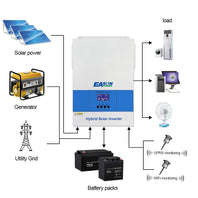As solar energy continues to gain traction globally, understanding the ultimate guide to solar charge controller features becomes increasingly important. A solar charge controller is a crucial component in any solar power system, regulating the voltage and current coming from the solar panels to the batteries. This article will explore the top ten essential features to consider when selecting a solar charge controller.

1. Type of Charge Controller
There are primarily two types of solar charge controllers: PWM (Pulse Width Modulation) and MPPT (Maximum Power Point Tracking). PWM controllers are generally more affordable and suitable for smaller systems, while MPPT controllers are more efficient and ideal for larger installations. Understanding which type suits your needs is vital.
2. Voltage Compatibility
Ensure that the solar charge controller is compatible with your solar panel and battery voltage. Most systems operate at 12V, 24V, or 48V. A mismatch can lead to inefficiencies or even damage to your equipment.
3. Maximum Current Rating
The maximum current rating of the charge controller should exceed the total current output of your solar panels. This feature is crucial for preventing overheating and ensuring the longevity of your system.
4. Display and Monitoring Features
Many modern solar charge controllers come equipped with LCD displays that provide real-time data on voltage, current, and battery status. Some even offer Bluetooth connectivity for remote monitoring via smartphone apps. Wouldn't it be convenient to monitor your system from anywhere?
5. Temperature Compensation
Temperature can significantly affect battery performance. A charge controller with temperature compensation adjusts the charging voltage based on the ambient temperature, ensuring optimal battery health.
6. Load Control Options
Some solar charge controllers feature load control options, allowing you to manage the power supplied to connected devices. This can prevent over-discharging of batteries and enhance the overall efficiency of your solar power system.
7. Protection Features
Look for controllers that offer various protection features, such as over-voltage, over-current, and short-circuit protection. These safeguards are essential for maintaining the safety and integrity of your solar power system.
8. Expandability
If you plan to expand your solar system in the future, consider a charge controller that allows for easy upgrades. This flexibility can save you time and money down the line.
9. Warranty and Support
A solid warranty and reliable customer support are indicators of a quality product. Ensure that the manufacturer offers a reasonable warranty period and accessible customer service for any inquiries.
10. Price and Value
Finally, while price is a significant factor, it’s essential to consider the value offered by the solar charge controller. Investing in a high-quality controller can lead to better performance and longevity of your solar system.
In conclusion, understanding the ultimate guide to solar charge controller features is crucial for making an informed decision. By considering these ten essential features, you can select a solar charge controller that meets your needs and enhances the efficiency of your solar power system. For a wide range of solar charge controllers, visit .







